 |
[ Outlaw Genealogy | Bruce
History | Lost Chords ] [ Projects | News | FAQ | Suggestions | Search | HotLinks | Resources | Ufo ] |
 |
[ Outlaw Genealogy | Bruce
History | Lost Chords ] [ Projects | News | FAQ | Suggestions | Search | HotLinks | Resources | Ufo ] |
We may in fact be related to the ancient family of "De Clare" - > the famous Clere family of Stokesby Blickling Norfolk :
Notice that Margaret Walshe mother was Olive - daughter of Robert CLERE of Stokesby
Notice the Outlaw connection to Pembroke (Bristol Wales) Killkenney (duplin Ireland) and "de Burgh's" This later Robert de Clere married Alice Boleyn - This all goes to point to how the Outlaw's were their men. t
This also shows how the relationship with King Henry VIII of Adam Outlawe and Simon Outlawe with the Clere's and the Walshes
Notice also that the grand mother of Margaret Walshe was Cicilie Daughter of Sir John Harseck (Harsyck) whose brass is found Castle Acre
Notice Margaret nee Walshe married John Outlaw of Dereham and had four children:
John Outlaw, Catherine Outlaw, Joane Outlaw, Cecily Outlaw
Page 260:
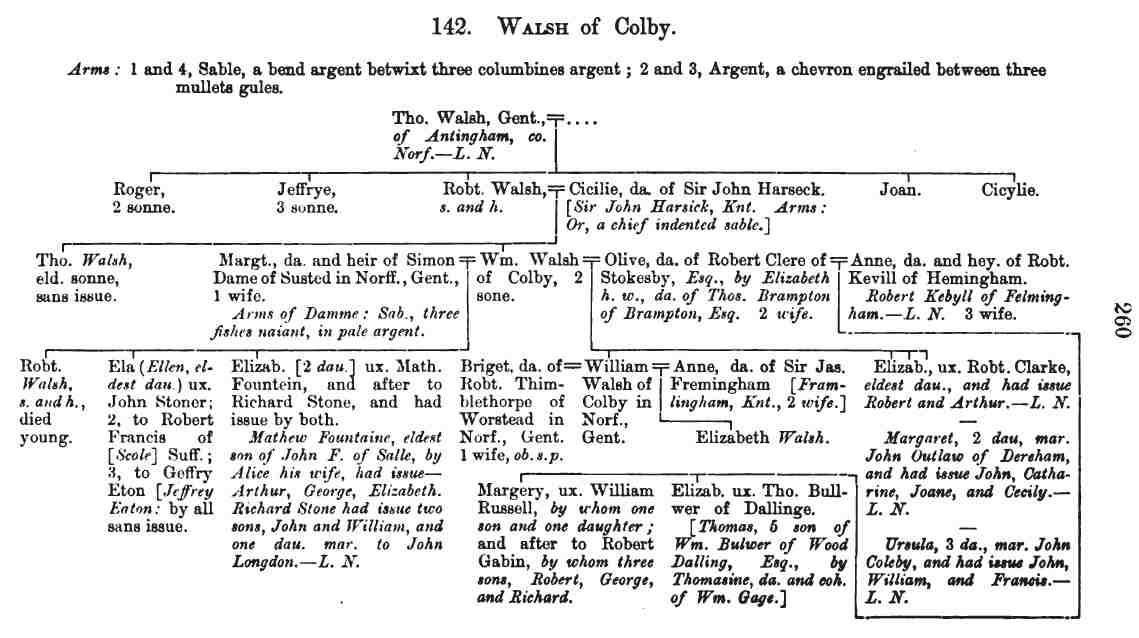
1567 - Outlaw (Owtelawe), John, elder, joiner, of East Dereham - Will. (A Joiner - Fine woodworker without using nails) ?
The Gentleman's Magazine - John Nichols
| - - - -
The early association to the De Clare family in Ireland / Gloucestershire - Bristol But he dies fight Robert the Bruce so what happened then? Need to find out more about Nicolas de Balscote - one would have to assume they presided over de Clare's will:
1313 - Earl
of Gloucester & Hereford names William OUTLAWE as one
of his attorneys. - Gilbert
de Clare, 8th Earl of Gloucester 1291-1314 (Ireland?) - Calendar
of the Patent rolls Vol-1 - Gilbert de Clare letters nominating Nicolas
de Balscote and William OUTLAWE as his attorneys in Ireland for 5
years
1313 - Gilbert
de Clare, Earl of Gloucester and Hertford, staying in England,
Westminster, has letters nominating Nicholas de Balscote and William Outlawe
his attorneys in Ireland for five years. May 1 - Westminster
1313 - Willielmus Outlagh - The Tallage of 6 Edward II - Bristollia Bristol - Tallage - Bristollia or, memoirs of the city ... - Gloucestershire - Bristol
1314 - Battle of Bannockburn - June 24 - Robert the Bruce defeats Edward II Army - After Earl of Gloucester was killed, the English army soon fell into disarray, and the battle resulted in a resounding victory for the Scots, and a humiliating withdrawal for the English. Robert the Bruce was the earl's brother-in-law ( Maud de Burgh ), and mourned his death
Nicholas de Balscote - ( died 1320 ) was an English-born official and judge in fourteenth-century Ireland: he achieved high office but was ruined by a quarrel with the Crown. ... He was born at Balscote in Oxfordshire, and was probably of the same family as Alexander de Balscot ... He is first heard of as an official of the Exchequer of Ireland in 1303, and was subsequently appointed Archdeacon of Glendalough. He became Chancellor of the Exchequer of Ireland in 1310, and Chief Baron of the Irish Exchequer in 1313.[3] In 1317 he was spoken of as Lord Chancellor of Ireland but not appointed. He became custodian of the Archdiocese of Dublin in the same year.
| - -- - -
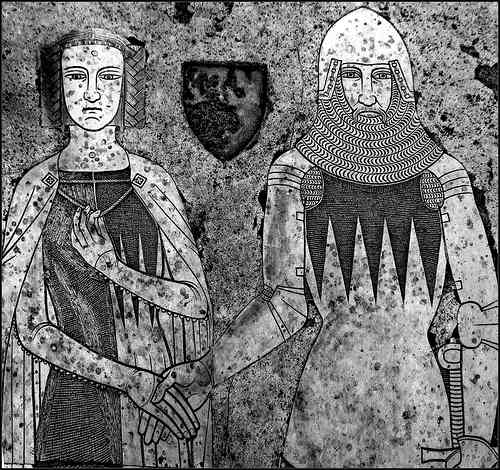 what
will survive of us is love - detail of the brass memorial
to Sir John Harsyck and his wife Katherine, 1384.
what
will survive of us is love - detail of the brass memorial
to Sir John Harsyck and his wife Katherine, 1384.
Nearby Castle
Acre is more famous, but the church of St
George at South Acre is both beautiful and interesting. The most famous
feature is the huge alabaster table monument to Sir Edward Barkham and his wife
1539 - Outlaw: pensioner - Gonville and Caius College, Cambridge
1541 - Adam
Owtlawe - (£30) - '1541 London Subsidy roll: Tower Ward
1542 - Simon
Owghlawe owns land in Upton, afterwards possessed by Thomas Clere, 1542.
Thomas Clere
also had land here which formerly belonged to John Reynes of Acle. — Court of
Wards and Liveries, vi. 129.
1542 - Simon
Owghlawe - Outlawe -
land in Acle, Mowton, Boyton, Northbyrlyngham Fysshely and Upton
1543 - Adam
Owtlawe - send four ships to the Downes - Feb 23 - Sir Francis
Bryan to the Kings Council - Scotch prisoners - (Sir
Francis Bryan was a distinguished diplomat,
soldier, sailor,
cipherer, man
of letters, and poet.)
(Henry VIII)
1543 - Westminster., 19 Feb. Bryan ^ ' that the King is advertised of the troubles we were in upon the seas and the danger and ruin of his ships, and that I was determined according to your commandment to send four ships to the Downes. The said ships were ready in Humber before the receipt of your letters, whereupon I sent a boat which has spoken with Mr. Clere and Mr. Carye, commanding them to lie off and on upon the coast between Humber and Newcastle, and as Mr. Nedygate and Adam Owtlawe were ready victualled I thought it more convenient that they should accompany Mr. Clere and Mr. Carye, than lie in harbour.
As Clere and Carye went forth of Humber they met a Scot of 30 tons laden with salmon, herring and barrelled fish with the lord Admiral's safe-conduct for George Browne and Ant. Papeworth, of Barwike, to bring, in Scottish ships or boats, certain fish to Berwike, Holy Hand, Aylmouth or Stakton at price therein limited (given). As the Scot had passed the places appointed and said he was going to Boston, Sir John [Clere] and Mr. Carye sent him to Hull, and I have stayed him and certified my lord Admiral. Clere also took a French boat, as I reported, which is at Newcastle, and the men, 31 and 3 Dutchmen, brought in the ships to Hull, and I have, by advice of Mr. Stanhop, delivered all 34 to the mayor to keep them and see them gently handled. Begs to know how their charges shall be paid. Here awaits the coming of Mr. Osborn with the King's further pleasure. The French have delivered an inventory of their goods, valued at 500 mks., which is sent to the lord Admiral. Hull, 23 Feb. Signed. Pp. 2. Add. Endd. : a xxxiiij .
[ Notice that Sir Francis addresses his "peers" as Mr. - Mister - (Master) and others like Adam Owtlawe, by their first and last names. ]
1544 - July 1544 Expedition to Calais - Captain Adam Owtlawe
1544 - Owtlawe, Adam, [no place] 21 pynnyng - Prerogative Court of Canterbury - Probate Wills page 397 - Is this the same man? Did he die at sea? He was alive in October, this reference has just the year , no month (FYI - This is the court that would be used for someone who had died at sea).
1545 - Will of Adam Owtlawe - 09 January 1545 - Records of the Prerogative Court of Canterbury - Pynnyng - The PCC was the most important of these courts dealing with relatively wealthy individuals living mainly in the south of England and most of Wales. If a property-owner in England or Wales died overseas, such as sailors or soldiers, then their will was proved in the Prerogative Court of Canterbury regardless of where their property was held. - Adam Owtlawe Will - Had a wife named Alice and a son named Thomas and/or a son named Adam (it is very hard to read, so if know old wills, have a look and let me know.)
1545 - Dec
22 - For a weye of salt delivered to Brymer Outlawe, 30s.
14l. 16s. 8d. - Henry VIII: Papers - Somehow Related? Relative of
Adam? BRYMER is of Belgium origin, a locational name meaning
'one who lived by the sea-shore'. Not a common first name.
The "weye of Salt" may have been a bereavement gift from Henry
VIII no less.
This was Sir John Clere:
CLERE, Sir John (1511-57), of London, Norwich and Ormesby, Norf. History of Parliament Online
The first son of his father’s second marriage, John Clere benefited little from the succession because part of the Clere estate was held by his half-brother’s widow and most of the remainder stayed with his mother during her life. That Sir Robert Clere mistrusted his son’s habits appears from the condition which he attached to a bequest of plate and a gold chain, ‘that he avoid riot and great gaming’, although as Sir Thomas Tyrrell, whose daughter John Clere married, was later to complain that he had been left not only to pay for the marriage feast but also to keep the couple in food and lodging for seven years, there does not appear to have been much scope for extravagance.3
Clere’s position improved in 1538, when on his mother’s death he gained possession of nearly 20 manors, mainly on the east coast of Norfolk: in the following year he was knighted and in 1540 he was put on the Norfolk bench. Thirteen years later he added to his patrimony the reversion of three manors bought from his uncle Sir James Boleyn, among them the future family seat of Blickling. Rarely on good terms with his neighbours, above all the Pastons, Clere was not infrequently in the Star Chamber, where one complainant criticized his ‘covetous appetite and ungodly disposition’. At least in Henry VIII’s time he could treat such attacks the more lightly in that he enjoyed the patronage of the Howards: the 3rd Duke of Norfolk had been overseer of his father’s will and his younger brother Thomas, a servant of the Earl of Surrey, was to be commemorated in one of Surrey’s sonnets after dying from wounds received when he saved the earl’s life in France in 1545. It was during this phase of Clere’s career that he attended his first two Parliaments as Member for Bramber, one of the Howard boroughs in Sussex. He was one of a group around Surrey arrested during the second session of the Parliament of 1542 for eating flesh in Lent.4
If it was as a courtier and a dependant of the Howards that he first came to public notice, it was as a naval captain and an administrator that Clere made his name. Early in 1548 he commanded a patrol in the North Sea and two years later he served in the Channel. His service at sea commended him to the admiral John Dudley, Viscount Lisle, whom in 1546 he accompanied to France to negotiate peace. Presumably he served under Dudley’s successor as admiral, Thomas, Baron Seymour of Sudeley, but nothing has come to light about his part in the Scottish war. Clere’s plundering of West Somerton church perhaps helped to foment Ket’s rebellion during 1548: he answered the Marquess of Northampton’s call for support from Norfolk gentlemen and after Northampton’s replacement by Dudley, then Earl of Warwick, he assisted in restoring order. Dudley rewarded him with lands said to have been promised to him by Henry VIII and with the treasurership of the army stationed in northern France until the surrender of Boulogne in 1550. His closeness to Dudley probably accounts for his Membership of the Parliament of March 1553 as much as his friendship with the leading resident at Thetford, Richard Fulmerston. During the succession crisis Clere seems to have declared for Lady Jane Grey and to have prevented a military force from Great Yarmouth from reaching Mary. When the tide turned in Mary’s favour his arms were impounded but he is not known to have been imprisoned.5
Clere sued out a pardon in October 1553 but was not reappointed to the commission of the peace. The marriage of his daughter to the Protestant Walter Haddon suggests that his sympathies were still on that side. His election as first knight of the shire for Norfolk in 1555 can thus scarcely have pleased the court and may have owed little to the new duke. In the Commons he had the bill enabling merchants to take coin out of the realm committed to him after its second reading on 22 Nov., but he did not align himself with the opposition as did his fellow-knight John Appleyard, and his appointment as vice-admiral at Portsmouth in the following year shows that he was regarded as politically reliable as well as professionally competent. His first mission, to escort Charles V on his voyage to retirement in Spain, brought him a gold chain from the ex-emperor, but his second was to prove fatal. In July 1557 he was given command of a fleet against Scotland which on 21 Aug. was surprised by an enemy force in the Orkneys, and in the engagement which followed he was drowned. Following his death the Council ordered an inquiry to be held into alleged disorders committed by his men in churches and religious houses in Scotland.6
Before setting forth Clere had made a will by which he left his lands in the care of his executors for five years; they were to pass to his son when he became 21. The executors, Richard Fulmerston, Walter Haddon, Walter Herendene and Robert Paynter, were to pay 50 marks a year for four years to Walter Haddon ‘for full satisfaction of 500 marks’, and 500 marks to ‘my son-in-law Walter Herendene’: both were clearly dowries. Clere’s two eldest sons had died, one in Florence, the other at Pinkie, and he was succeeded by his youngest son Edward.7
Blickling Norfolk :
Blickling Hall is a stately home in the village of Blickling north of Aylsham in Norfolk, England, that has been in the care of the National Trust since 1940.
In the 15th century, Blickling Hall was in the possession of Sir John Fastolf of Caister in Norfolk (1380–1459), who made a fortune in the Hundred Years' War, and whose coat of arms is still on display there. Later, the Hall was in the possession of the Boleyn family, and home to Sir Thomas Boleyn, created Earl of Wiltshire, and his wife, Elizabeth, between 1499 and 1505. It is presumed that their first two children Mary and George were born at Blickling Hall, along with several other Boleyn infants who did not live long. If the couple's most famous child, Anne Boleyn, was born before 1505 (as one school of historical thought contends) then she too was born at Blickling. Other historians maintain that Anne was born after 1505, probably in 1507, and by that time Sir Thomas had moved to Hever Castle in Kent. Nonetheless, a statue and portrait of Anne Boleyn reside in Blickling Hall claiming "Anna Bolena hic nata 1507" (Anne Boleyn born here 1507). ,... Blickling from Robert Clere in 1616
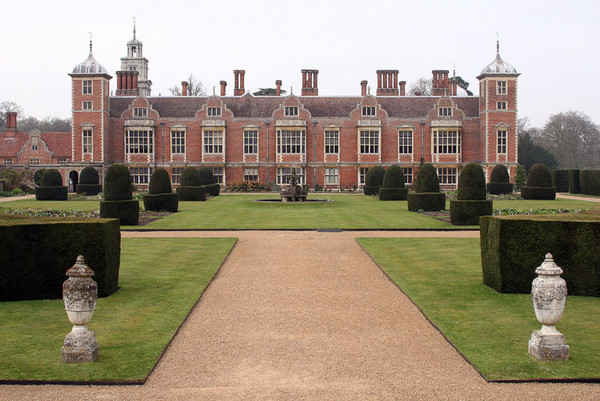
Interesting to look at other sites near VG-62 in Västergötland Sweden hmmm....
700~1000AD - Útlagi
placed this stone in memory of Sveinn -Rune sm103 - Småland,
Sweden
990~1010AD - Utlage
raised this stone in memory of Öjvind, a very good thegn -
Rune vg62 - Ballstorp, Västergötland, Sweden
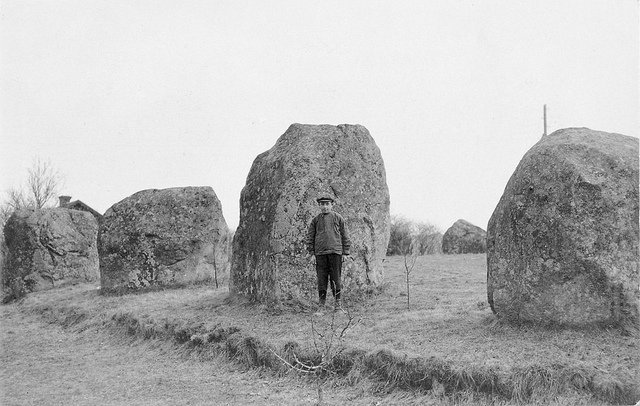
Stone ship in Askeberga, Västergötland, Sweden. (~400-500AD) (Credit: Image courtesy of University of Gothenburg)
Askeberga
Askeberga stone ship is
one of Västergötland's most notable archaeological sites. It
is 53 meters long and the second largest in the country after Kåseberga in Skåne.
Ships are based is built
of 24 giant blob blocks of between 25 and 30 tons each.
Ships Subsidence is
typical Nordic relics consisting of standing stones made in the shape of a ship.
The size of the
formation may vary from a few meters up to 30 meters. Often
marks the stone ship a grave, but not always. The
design may also have had symbolic or ritual function.
Ships are based is often
a graveyard. It
has been dated Askeberga ship setting the Migration Period (about 400-500
e.Kr). The
place has since time immemorial been a gathering place for the people of the
district. The
oldest name of the place must have been Asgudsbäck, better known, however, Ranes
stones - Odin stones - when Rane during a period in the Lake Vänern area was a
name for Odin.
Tanner_Gregory_Rune_Stones_and_Magnate_Farms
...
Ranes stenar: Odin’s hall?
The modern site of Askeberga in Vadsbo Hundred, located approximately one kilometer to the east of Odens sjö is home to the remarkable stone monument known as Ranes stenar, or Odin’s Stones. The monument consists of 24 stone blocks in the form of a Viking great hall, some of which weighing up to 30 tons each. It is 55 meters long and 18 meters wide, and its construction must have taken considerable effort, organization and man-power (Lindblom 1982, p. 20).
In many contemporary sources and on current maps Ranes stenar is somewhat frustratingly often miss-referred to as a stone ship monument. There are several problems with this interpretation: To begin with, and I think the most obvious are the open ends on both ends of the hall. In all stone ship monuments, there is a prow, and stern stone, one usually being taller or larger than the other to indicate which way the ship is “sailing”. These are both missing at Ranes stenar (Råsled 2005, p. 1.).
Also of interest to Ranes stenar, and possibly strengthening the Valhalla/Odin cult theory is the fact there is only one other similar stone monument to it in all of Scandinavia, and it just happens to lie in Nässjä, five kilometers southwest of the town of Vadstena, directly to the east of Vadsbo Hundred on the eastern shore of Lake Vättern in Östergötland County.
Råsled’s theory on the number of stones themselves and not just a similarity in their placement and form to Valhalla, which I also find very interesting and possibly strengthening as to the idea of a cult purpose being the underlying factor for the construction of the two hall monuments was thus: There are 24 stones in both of the monuments. There are 24 runes in the Elder runic alphabet. Ranes stenar is believed to have been constructed during the Iron Age so this could also seem to support a conscious connection to the earliest runic alphabet (Råsled 2005, p. 9).
Also of note in terms of an Odin cult connection is the fact that during the Viking Age it was believed that Odin himself was the creator and keeper of the runes and their magic, and the runes themselves were the key he could use to make words and make mankind speak, write, read and obey. The runes were to be feared and respected. He who kept and could write the runes also had the power of them (Råsled 2005, p.9).
...
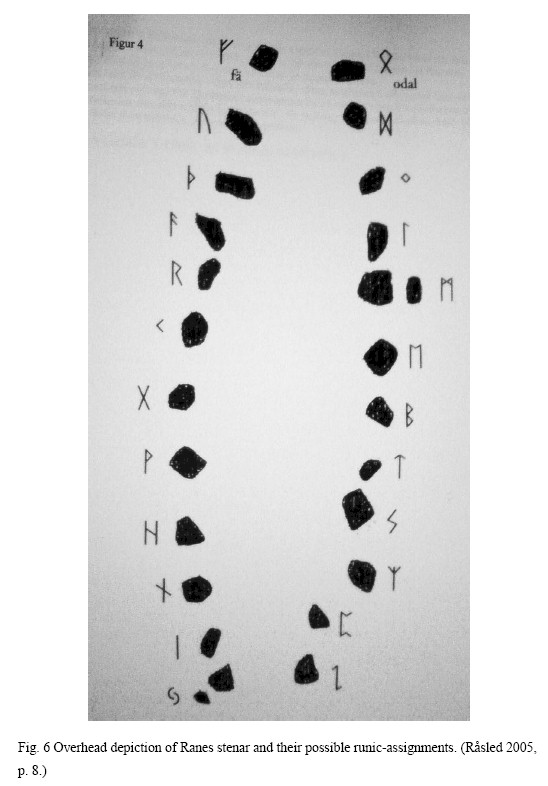
Askeberga [Vad 101] Stone Circle The Megalithic Portal and Megalith Map
Stone Circle' in Västergötland. Stone ship setting. Described as second largest in Sweden (after Ales
Stenar, presumably).
Additional information submitted by Drew Parsons in September 2011: This stone setting is dated to the Late Iron Age around 1000 to 1500 years ago. It comprises
24 huge stones some up to 3 metres high and at 55 metres by 18 metres it is a very impressive site. The site sign suggests that the stones which are set out like a ship may alternatively been a representation of a Late Iron Age long house.
| - - - -
Nässja stone circle
Nässja stone circle is not really a stone circle, but old grave, which is estimated to be from the old Iron Age, built by
24 large stones that have been placed in an oval ship- like form.
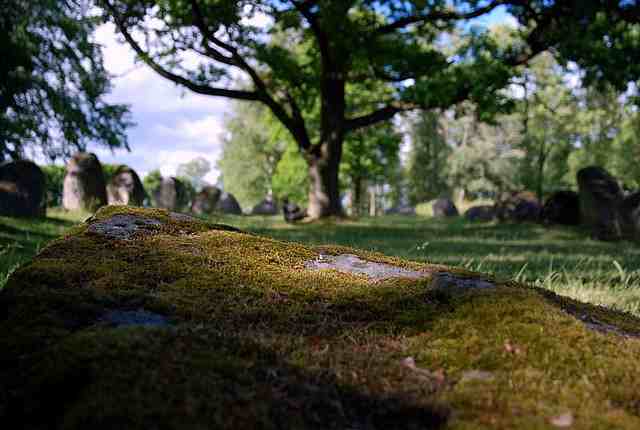
Nässja domarring Barrow Cemetery The Megalithic Portal and Megalith Map
Östergötland
Nässja domarring, Skibssætning, The big ship, made of 24 stones, 10 are standing, it is one of the largest in stone boats in
Sweden. The other 23 graves are round, flat barrows, except for quadratic one, with standing stones in the corners.
The biggest of the flat barrows has been reworked in later times to be used as a fundament for a windmill.
Stone circle (Iron Age) - Wikipedia, the free encyclopedia
One stone circle, the circle of Nässja (near Vadstena), comprises as many as 24 stone
There is a widespread tradition that the circles were used for things, or general assemblies. Similar circles were used for popular assemblies in Denmark until the 16th century, and in Vad parish in Västergötland, the village assemblies were held in a stone circle until the 19th century.
Stone Ships of Vikings - Google Groups
20. Nässja Stone Ship, Sweden
The Nässja Stone Ship located in Nässja Parish, Vadstena Municipality, Östergötland, Sweden, measures 44×18 metres and is made of 24 large stones, of which 10 are standing. The stone circle was excavated in 1953.
One peculiarity of this ship is that the bow and stern stones are missing. [
Because like the study document shows it
is a Hall not a boat ]
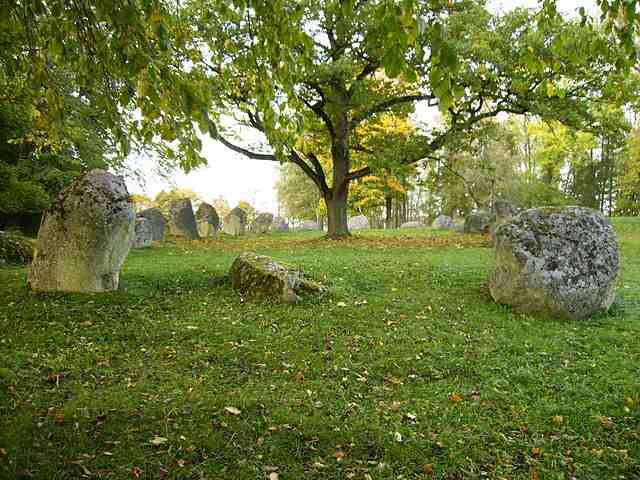
| - - - - - - -
Kung Ranes hög - Kung Ranes hög och kyrkan i Flistad - YouTube
Kung Ranes Hog - Mound Sweden - 800-1000AD - VasterGotland Flistad
| - - - - -
The Viking Stonehenge (Kåseberga, Sweden)
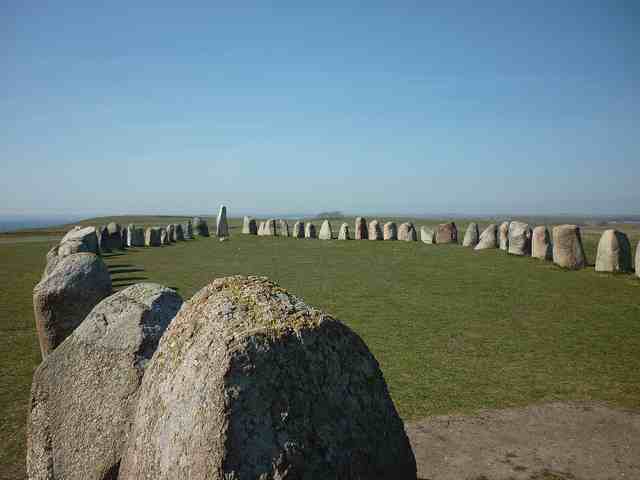
Kaseberga - Ales Stenar - Notice this has a ships prow.
1401 - King Henry IV suggests alliance of England and Kalmar
[ This is interesting since the daughter of King Henry IV is married off to the Danes! Philippa_of_England ]
Vadstena Abbey
- The Abbey of Our Lady and of St. Bridget (Latin: Monasterium sanctarum Mariæ Virgìnis et Brigidæ in Vatzstena), more commonly referred to as
Vadstena Abbey, situated on Lake Vättern, in the Diocese of Linköping, Sweden, was the motherhouse of the Bridgettine Order. The abbey started on one of the farms donated to it by the king, but the town of Vadstena grew up around it. It was active from 1346 until 1595.
The abbey was founded in 1346 by Saint
Bridget with the assistance of King Magnus
IV of Sweden and his Queen Blanche
of Namur, who made a will donating ten farms, including that of Vadstena in Dal
Hundred, Östergötland,
to the abbey founded by Bridget.
...
The canonization
of Saint Bridget in 1391 and the translation
of her remains to the Abbey Church in 1394 added greatly to the fame and riches
of her community.
In 1400 Duke Eric
of Pomerania was invested at Vadstena by his great-aunt, Queen
Margaret, as King of Denmark, Norway and Sweden. The grave of his wife,
Queen Philippa,
and that of Catherine,
Queen
Consort of King Carl
II of Sweden, are located here.
...
Vadstena Abbey also had international fame as the motherhouse
of all the monasteries of the Bridgettine Order, such as Reval, Nådendal,
Bergen and Danzig. It kept in contact with other monasteries, performed
inspections of them and sent both nuns and monks to them when they were lacking
in members. In 1406, for example, an English delegation arrived asking for
members in order to establish a Bridgettine monastery in England,
and in 1415, four nuns, three female novices, one monk and one priest left the
abbey under great celebrations for the foundation of what became the famed Syon
Abbey.
Philippa_of_England - (4 June 1394 – 7 January 1430), also known as Philippa of Lancaster and anachronistically as Philippa Plantagenet, was the Queen of Denmark, Sweden and Norway from 1406 to 1430. She was the consort to Eric of Pomerania, who ruled the three kingdoms. Queen Philippa served as the de facto regent of Sweden in 1420 and the regent of Denmark and Norway from 1423 to 1425
Philippa was born to Henry Bolingbroke, later Henry
IV, King of England and Mary
de Bohun at Peterborough
Castle, Peterborough.
...
Her head lady-in-waiting was the Swedish noblewoman Lady Katarina Knutsdotter,
granddaughter of Saint
Bridget and former lady-in-waiting of Queen Margaret
I of Denmark herself. She was a benefactor of Vadstena
Abbey, where she was a frequent guest.
...
The queen bore a stillborn boy in 1429. She died on 7 January 1430 (possibly
murdered by her lady in waiting Cecilia)
and was buried in the Cloister Church at Vadstena,
close to Linköping
in Östergötland,
Sweden. After
her death Eric replaced her with Cecilia.
---- >>> Back to Outlawe Research Journal - Page 10